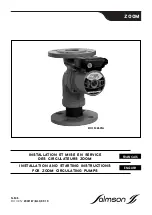
27
2. Inspect the venting system for proper size and horizontal pitch,
as required in the National Fuel Gas Code, ANSI Z223.1 or the
Natural Gas and Propane Installation Code CAN/CSA-B149.1
and these instructions. Determine that there is no blockage or
restriction, leakage, corrosion and other deficiencies which
could cause an unsafe condition.
3. So far as is practical, close all building doors and windows
and all doors between the space in which the water heater(s)
connected to the venting system are located and other spaces
of the building. Turn on all appliances not connected to the
venting system. Turn on all exhaust fans, such as range hoods
and bathroom exhausts, so they shall operate at maximum
speed. Close fireplace dampers.
4. Follow the lighting instruction. Place the water heater being
inspected in operation. Adjust thermostat so appliance shall
operate continuously.
5. Test for draft hood spillage at the relief opening after 5 minutes
of main burner operation.
6. After it has been determined that each appliance connected
to the venting system properly vents when tested as outlined
above, return doors, windows, exhaust fans, fireplace dampers
and any other gas burning appliance to their previous conditions
of use.
7. If improper venting is observed during any of the above tests,
the venting system must be corrected.
WARNING
FAILURE TO CORRECT BACK DRAFTS MAY CAUSE AIR
CONTAMINATION AND UNSAFE CONDITIONS.
• If the back draft cannot be corrected by the normal method or
if a suitable draft cannot be obtained, a blower type flue gas
exhauster must be employed to assure proper venting and
correct combustion.
PREVENTIVE MAINTENANCE
CHECK THE PILOT
At least once a year, check the pilot burner, fig. 15, and the main
burner, fig. 16, for proper operation. Refer to the following pilot
and main burner sections.
PILOT BURNER
For access to pilot, unfasten two screws to burner cover and
remove. Locate the burner with pilot and remove screw holding
burner to manifold. Unfasten pilot tubing from valve and slide out
burner and pilot.
Servicing of the pilot burner includes keeping pilot free of lint,
cleaning the burner head, the primary air opening and the orifice
of the pilot burner.
Pilot burner flame is affected by:
1. Low gas pressure.
• Adjust pilot flame by means of the pilot gas adjustment
located on the gas valve. See fig. 17.
• The pilot flame should envelop sensing device with 5/8”
(1.6cm) flame, fig. 16. Remove pilot adjustment cover screw,
fig. 15. Turn inner adjustment screw clockwise to decrease, or
counterclockwise to increase pilot flame. Be sure to replace
cover screw on gas valve after adjustment to prevent possible
gas leakage.
2. Clogged pilot burner orifice.
•
Clean or replace orifice. A clogged orifice will restrict
gas flow.
3. Incorrect orifice.
• Replace. See Table 7, for correct orifice for type of gas
used. Orifice size is stamped on the wrench flats.
FIGURE 14
Pilot sensing device must sense a flame before sparking will stop.
Loose wires or a draft may cause intermittent or abnormal sparking.
To eliminate this condition, first correct loose wiring condition, and
then, if necessary, increase pilot flame.
PILOT BURNER ASSEMBLY
FIGURE 15
MAIN BURNER
The main burner, fig. 16, should display the following
characteristics:
• Cause rapid ignition and carry over of flame across entire
burner.
• Give reasonably quiet operation during ignition, burning and
extinction.
• Cause no excessive lifting of flame from burner ports.
Summary of Contents for CG 120 THRU 400A
Page 35: ...35 NOTES...










































